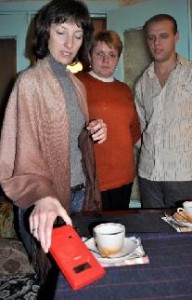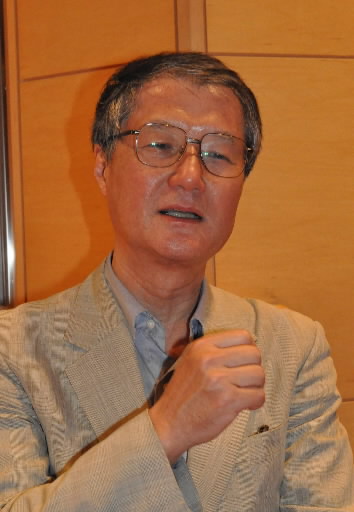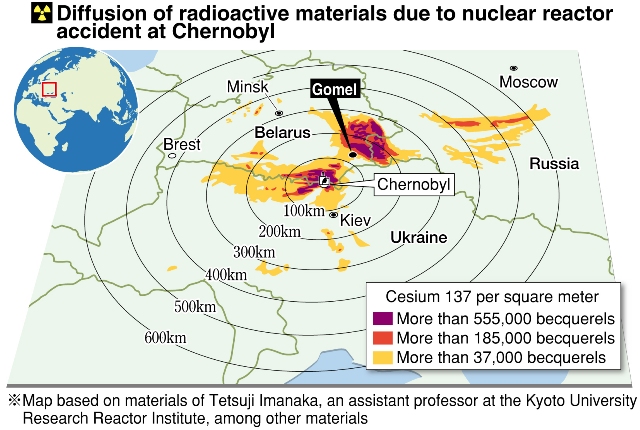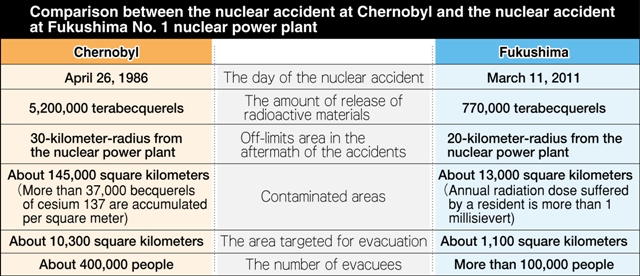Fukushima and Hiroshima: 25 years after the Chernobyl disaster
Oct. 31, 2011
Continued exposure to radiation
by Yo Kono, Staff Writer
The accident at the Fukushima No. 1 (Daiichi) nuclear power plant was rated Level 7 on the International Nuclear and Radiological Event Scale, on a par with the 1986 accident at the nuclear power plant in Chernobyl, which until then had been the worst disaster ever. Twenty-five years have passed since the accident occurred in Ukraine, which was then part of the Soviet Union. From late September into October I spent time in neighboring Belarus, where contamination from the accident was the worst. Even now residents are concerned about health problems that may arise from their exposure to radiation, and the contamination of the area has prevented them from returning to their hometowns. How can the lessons of Chernobyl be put to use to ensure that Fukushima does not go down the same path? With this in mind I visited the scene of the disaster.
Belarus most contaminated nation in Chernobyl disaster
A herd of 100 dairy cows lazily grazed on grass in the province of Gomel in Belarus, which borders Ukraine. Gomel is situated about 150 km northeast of the nuclear plant in Chernobyl. The milk produced here is still subject to testing for radioactive contamination.
Carried by the wind, radioactive materials fell over approximately one quarter of Belarus. The government of the former Soviet Union estimated that more than 37,000 becquerels of cesium 137 per square meter accumulated over more than half of Gomel province. This works out to an annual dose of radiation of more than 0.5 millisievert. The half-life of cesium, the time required for half of a substance to disintegrate, is approximately 30 years.
Of course, food products must meet strict standards set down by the government before they can be distributed in Belarus. But there have been quite a few instances in which radioactive substances have been detected in the bodies of residents. One reason is that many people live off the land. Some people also believe that the government’s tests themselves are inaccurate.
“How long will we have to live in fear of radiation?” said Tatiana Kislenov, 35, a housewife living in the city of Gomel, the administrative center of the province. She worries about her 6-year-old son being exposed to radiation and carries a dosimeter with her whenever she goes out.
An area 30 km around the nuclear power plant is still off limits. The hopes of about 116,000 former residents to return to their homes have not been realized. A permit from the government is required to report in the area around the nuclear power plant. “If you go there without permission, you’ll be arrested,” my driver warned.
Testing of food products, mothers who worry about their children’s health and rely on dosimeters, restricted access to the area around the nuclear power plant – all of these can be seen in Fukushima as well.
Kiyoshi Matsuzaki, 60, a native of Iwaki in Fukushima Prefecture is interim charges d’affaires at the Japanese embassy in Belarus. “I never dreamed the same sort of tragedy would occur in my hometown,” he said. “Fukushima can – must – learn a lot from Chernobyl.”
Radioactive iodine accumulates in the thyroid gland in the neck. According to a report prepared by the United Nations Scientific Committee on the Effects of Atomic Radiation, more than 6,000 people, mostly children, developed cancer as a result of the Chernobyl disaster.
Seven years after the accident, when she was 16, Elena Novikova, 34, a company employee who lives in Gomel, had her cancerous thyroid gland removed. “As a victim of a nuclear power plant disaster myself, I feel terribly worried about the children of Fukushima,” she said of the disaster area 8,000 km away.
Valealia Sekochik, 26, who served as my interpreter, studied at Hiroshima University for four years starting in 2006. She was born and raised in the province of Brest, which was heavily contaminated by radiation. She said she chose to study in Hiroshima because she had long had an interest in the atomic bombing. While studying at Hiroshima University she visited Hiroshima Peace Memorial Museum five times.
This spring, when she underwent a test using a whole body counter, a minute amount of cesium was detected. She was told that it was highly likely that she ingested it via food.
I saw a product on the shelves of a supermarket in Belarus whose label stated that it would promote the excretion of radioactive substances. I purchased some and found that it was a brown powder that smelled like apples. There was apparently no scientific basis for the claim that it would promote the excretion of cesium. I was told that some people purchase it as a sort of nutritional supplement.
“Unfortunately, it’s a fact that in this country people are still ingesting radioactive substances with their food,” Ms. Sekochik said. “It’s important to learn to live with the risks.” Her effort to seem positive was touching.
An interview with Tetsuji Imanaka of the Kyoto University Research Reactor Institute
Learn importance of thorough decontamination
Tetsuji Imanaka, a research associate at the Kyoto University Research Reactor Institute, has conducted surveys at the site of the Chernobyl nuclear power plant disaster for about 20 years. The Chugoku Shimbun asked him what should be learned from the Chernobyl disaster. The following are excerpts from that interview.
What is the most important lesson of to be learned?
The government of the Soviet Union started decontaminating the area but then gave up. So, 25 years later, people are still unable to return to their homes in the evacuation zone. Last May I measured radioactive materials in a forest near the village of Norodichi, Ukraine, in the forced evacuation zone about 70 km west of the nuclear power plant. I detected 0.5 microsieverts each time. This is about 10 times the amount of natural radiation.
What is needed most in Fukushima now is thorough measurement of radiation and decontamination. For the evacuees, who want to return home as soon as possible, the radiation of each house in the designated evacuation zone should be measured and the contamination should be mapped by neighborhood. If radioactive materials are thoroughly removed from the areas in which decontamination is possible, the evacuees should be able to return home sooner.
What were the results of your recent field surveys?
My most recent visit to Belarus was in May of last year, the time I went to Ukraine. I asked researchers there to show me the results of their measurements using whole body counters. The doses of cesium 137 in children in the contaminated area peaked in October and November. I was told that that was because they had eaten mushrooms, strawberries and other things that were picked in the forest during summer vacation. These results were about the same as Japan’s standard for imported food products, but internal exposure to radiation is still occurring.
When I asked about their estimate for total annual internal exposure, I was told that the government has prohibited them from making estimates of radiation doses on their own.
How did the Soviet Union disclose information after the disaster?
The government of the Soviet Union completely stopped disclosing the results of measurements of radiation just after the disaster just like in Japan this time. A map of the area contaminated by the Chernobyl disaster was not made public until three years after the disaster. It was published in a newspaper in Belarus and showed that the contamination was spread over a wide area. I was shocked.
What sort of compensation are those who evacuated the area around the nuclear plant in Chernobyl receiving now?
On my last trip I visited Kiev, the capital of Ukraine, and talked with evacuees. They were not only provided with housing by the government on a priority basis, they have also received allowances for food, rent, utilities and school lunches for their children.
Ukraine inherited the Soviet Union’s socialist system, so the compensation was generous. But because only evacuees received preferential treatment, some felt other people were envious of them or prejudiced against them. I sensed the difficulty of trying to decide what should be done in Fukushima in that regard.
Tetsuji Imanaka
Born in Hiroshima in 1950. Graduated from Osaka University with a degree in nuclear engineering. Went to work at the Kyoto University Research Reactor Institute in 1976 after receiving a master’s degree from the Graduate School of Engineering at Tokyo Institute of Technology. Expert in nuclear engineering. His mother, who died in November of last year, was a survivor of the atomic bombing of Hiroshima.
Chernobyl Nuclear Power Plant Disaster
The No. 1 reactor at the plant went into operation in 1978. On April 26, 1986 control over the No. 4 reactor was lost, and it burst into flames. The disaster was believed to be the result of flaws in the design of the reactor and violations of regulations by operators.
Over the next 10 days 5.2 million terabecquerels (the prefix “tera” represents 1 trillion) of radioactive substances were released. An area of 145,000 square kilometers, including parts of Russia, Belarus and Ukraine, was contaminated. Between 600,000 and 800,000 military personnel and construction workers took part in the effort to deal with the accident. The World Health Organization believes that at most 9,000 people died as a result of exposure to radiation. Approximately 400,000 people, including those who were ordered to evacuate, moved out of the area. About 5 million people still reside in the contaminated region.
In order to prevent the spread of radioactive materials, the power plant was sealed inside a concrete sarcophagus. The condition of the sarcophagus is deteriorating, and there is a plan to put a steel cover over it, but implementation of the plan has been delayed because of a lack of funds.
Compensation for Victims of the Chernobyl Nuclear Power Plant Disaster
According to the Hiroshima University’s Institute for Peace Science, victims in Ukraine can undergo free physical examinations once every two years, and children from kindergarten through the fourth grade receive free school lunches. Under the assumption that a family needs 4,000 hryvnia (approximately ¥52,000) per month to lead an ordinary life, a monthly food allowance of 160 hryvnia (approximately ¥2,100) is provided per person. After the accident, victims were given priority on moving into apartment housing. Ending the 50 percent tax exemption for rent and utilities has been suggested.
In Belarus as well there are laws providing for aid to the victims. They are offered jobs and are allowed to take special vacations in the summer. People who suffer from disorders of the thyroid gland receive a monthly allowance of 500,000 Belarusian rubles (approximately ¥5,000), an amount equivalent to one fourth of the average monthly income.
(Originally published on October 27, 2011)











